Sensory adaptations in exotics - NMSK
1/48
There's no tags or description
Looks like no tags are added yet.
Name | Mastery | Learn | Test | Matching | Spaced |
|---|
No study sessions yet.
49 Terms
Why is it important to be aware of the different sensory organs in exotics?
The relative importance and anatomy varies depending on:
species
habitat
diet
lifestyle
Need to consider how each organ is relevant to each species and what may affect it.
Which snake species use infrared detection
pythons, boas and pit vipers
why do snakes use infrared detection?
enables them to ‘see’ infrared
gives them night vision
can see small and very still prey
can detect prey
pinpoint where to strike
Why is infrared detection in snakes clinically relevant?
anorexia is common in captivity
should we be able to get a special license to feed live prey?
What is the vomeronasal organ?
paired, accessory olfactory organ
used for chemosensory stimuli
what are chemosensory stimuli detected in some species?
social or reproductive behaviour
in what species do we find the vomeronasal organ?
amphibians
lizards
snakes
many domestic species
in which species is the vomeronasal organ NOT present?
fish
birds
chelonians
what varies with the vomeronasal organ and what may if be connected to
anatomy and exact location varies
may be connected to the mouth via nasopalatine duct
Outline the vomeronasal organ in squamates
present in lizards
very well developed in snakes
roof oral cavity
vomeronasal nerve = branch of olfactory nerve CNI
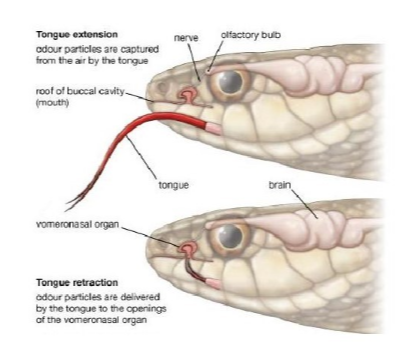
Why do snakes flick their tongue?
how snakes monitor their environment
take chemicals from the air presenting them phemoronasal organ in the dorsal part of the nasal cavity
Outline reptile ears
external ear is absent or diminished (in most species except crocodiles)
tympanum absent in some species
if it is present, it’s superficial.

Outline the structure of the ear organ in birds and reptiles
much simpler
1 auditory ossicle = columella (equivalent to the stapes)
connects tympanic membrane to the inner ear
cochlea duct is not coiled (poor hearing)
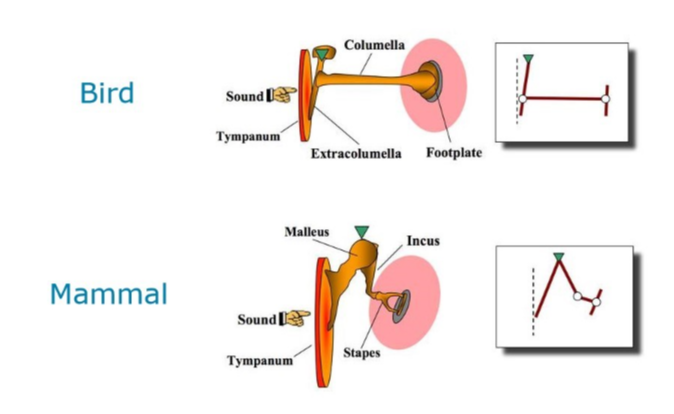
Outline snake hearing
no tympanic membrane
Quadrate bone connects to stapes (columella) to oval window of cochlea
low frequencies
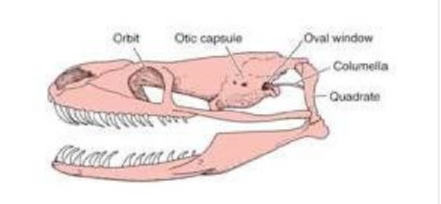
Outline hearing in birds
hearing is their 2nd most important sense
particularly important in nocturnal birds
some species use magnetic force, some use echolocation
what special adaption do birds have?
regenerate hair cells if they get damaged
Outline ear anatomy in birds
outer, middle and inner ear
no pinna, they have specialised feathers
can have ear lobes
some have an operculum
2 tympanic membranes in songbirds
short external auditory meatus
single auditory ossicle
what is the operculum
found in owls
accessory structure
aids sound location
What type of feathers are on owl heads
auricular feather
contour feathers
reflector feather
Outline owl ear structure
tightly packed rim of facial feathers
sound → external auditory meatus
left and right external auditory meatuses are different sizes and shapes
helps to localise sounds
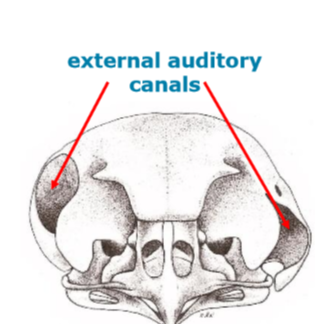
Why do owls have asymmetrical external auditory canals
enables precise pinpointing of prey
intensity and timing of sounds
horizontal and vertical planes
How are fish able to hear/detect acoustic information
auditory system - otolithic inner ear
mechanosensory system = lateral line
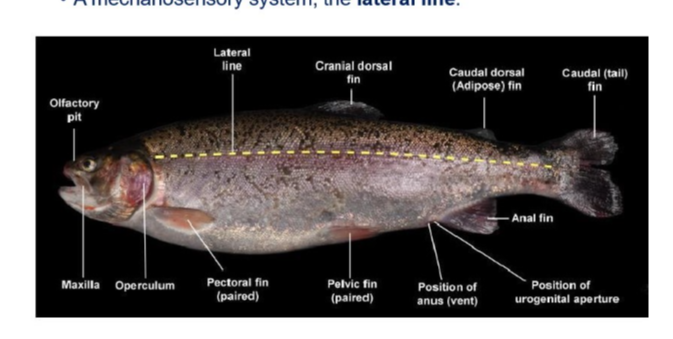
Where do we find the lateral line
runs just below the surface of the skin
along the side of the body
covered by pored scales
What is the lateral line used for?
detects movement
vibration
pressure gradients
used for:
detecting obstacles
swimming in schools
avoiding predators
How does vision in the air compare to vision in water
air: light is strongly refracted through the cornea - cornea focuses
water: cornea/water have a similar refractive index = lens focuses instead
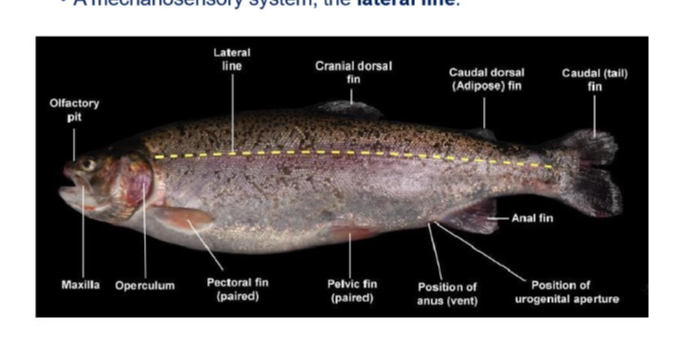
Outline fish eye anatomy
generally, large variation in species structure/shape/colour
most can see colour (some see UV light)
rod: cone ration varies
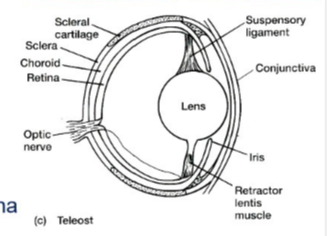
What are the main differences in fish eye anatomy to mammalian anatomy
no lacrimal gland
rigid, immoveable iris
pupil is fixed
lens: spherical, protrudes through the iris
light is focussed by the lens changing position in relation to the retina
What keeps the lens in place in fish
suspensory ligament dorsally
retractor lentis muscle ventrally
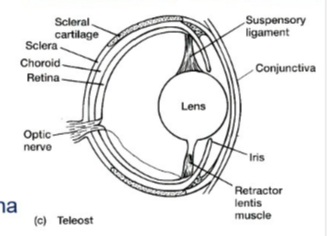
outline the nictitating membrane in reptile and birds
very present in reptiles
very developed in birds
it’s a striated muscle
rapidly sweeps and cleans the cornea
outline the lower eyelid in birds and reptiels
more mobile
larger in birds
what are scleral ossicles and what are their function?
bones within the sclera
provide protection and support
aid ciliary muscle function (visual accommodation) - especially relevant in night vision
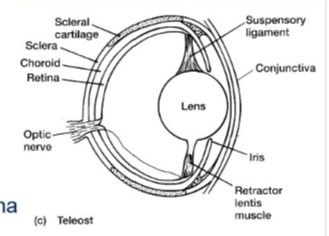
What is the fovea
lots of rods and cones
enables sharp vision and visual acuity
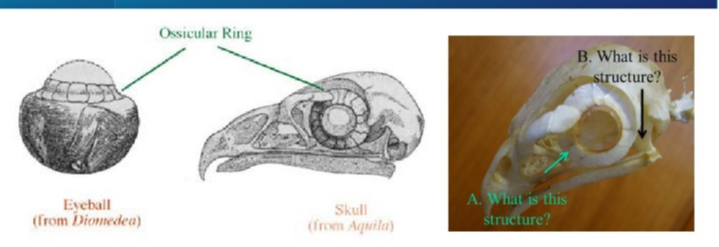
In which species is the fovea present
fish, reptiles, birds and primates
In which species do we find 2 fovea and what do they enable?
diurnal species, especially raptors
enables:
wide, binocular field of view
very sharp vision
Outline avian eye structure
relatively large: socket size = exophthalmic
no tapetum lucidum
avascular retina
pecten
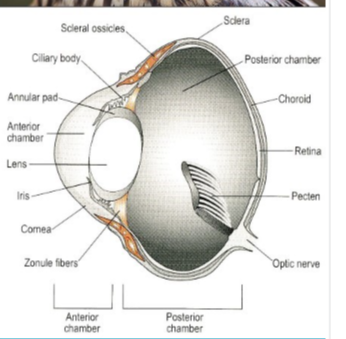
Why is having an avascular retina beneficial for birds?
less light is scattered from the blood vessels
provides higher visual acuity
What is the pecten?
highly vascularised
thin
highly folded
think it has a nutritive role for the retina
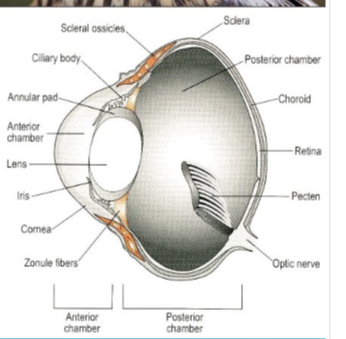
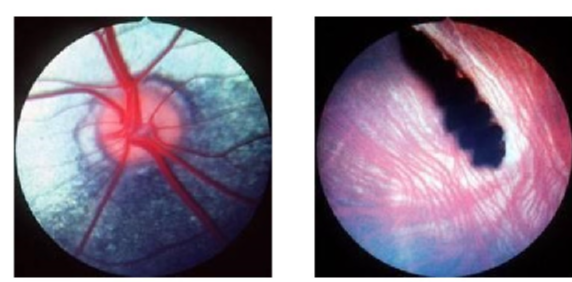
What species are these?
Left = goat fundus
Right = avian fundus - see the pecten
What do we look at for clinical relevance of the avian eye?
note the normal appearance of the pecten
head trauma;
common in birds of prey
remember - must triage and provide first aid to all species
if the pecten is destroyed, must euthanise
What can birds see
some birds can see colour
many nocturnal birds can see UV light
Diurnal birds have a higher proportion of cones
nocturnal birds have a higher proportion of rods
what should we do in practice with diurnal birds to ease handling/catching and why
dim the lights
higher proportion of cones
Outline squamate eyes
retina is avascular
± papillary cone (in lizards and some snakes)
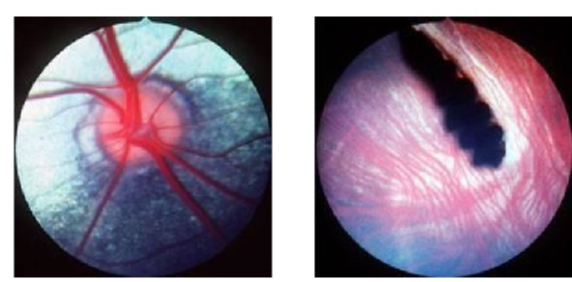
Outline the spectacles in snakes and some lizards
fused eyelids, transparent
subspectacular space
shed during ecdysis (colour change)
What is the clinical relevance of dyseccdysis
retained spectacles
correct husbandry
rehydration = important (bathe in warm water daily)
apply eye lubricant
gently lift the spectacle off the eye using a wet cotton bud, from the very edge of the eye
never just pull skin off
Outline the pineal gland in reptiles
endocrine gland in brain
it’s in msot vertebrate species
produces melatonin
involved in sleep/wake cycles: responds to light/dark
outlien the parietal eye in lizards
‘third eye’ - a photoreceptive structure
usually ontop of the head
in many lizard species (and amphibian)
lens, cornea, retina
produces and secretes melatonin
involved in: light/dark, sleep cycle, hormone production, thermoregulation
what is the clinical relevance of the PLR in reptiles and birds
can’t be use to assess
both eyes are under independent control
what is meant by a consensual PLR
the PLR affecting the contralateral eye
Can we use mydraitics in birds and reptiles?
no
iris and ciliary muscle are skeletal muscle not smooth
under voluntary control